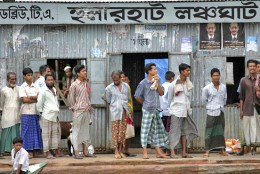Rocket steamer Steam paddle boats, locally known as ‘Steamers’, ‘steamer rockets’ or simply ‘Rockets’, were introduced in Bangladesh in the second quarter of 19th Century. Originally these passenger vessels used to operate with steam engines produced in Denny yard on the Clyde. But in 1995 all of the steam engines have been replaced by diesel engines. The three rocket steamers that still operate between Dhaka and Khulna are Mahsud, Ostrich, and Lepcha. Having a trip on a steamer lets you relax for a while and gives you a very interesting introduction of the rural Bangladesh.
Sixty Domed Mosque
This is the largest of the Sultanate mosques in Bangladesh and one of the most impressive Muslim monuments in the whole of the Indian subcontinent. Built in the 16th Century, the mosque does not have sixty Domes as the name might mislead, rather sixty Pillars and 77 domes. Probably the name sixty Gumbad (Pillars) turned into Gambud (Dome) to raise such name in Bangla.
The mosque proper, built mainly of bricks, forms a vast rectangle and measures externally, inclusive of the massive two-storied towers on the angles, 48.77m from north to south and 32.92m from east to west. The huge of the building has been supported by Stone pillars. It is one of the three UNESCO heritage sites of Bangladesh and offers a tranquil neighbourhood for the visitors. There is a museum at the site to make a visit through the history for you too.
Nine Domed Mosques
Nine-Dome Mosque is located on the western bank of the Thakurdighi, less than half a km southwest to the tomb-complex of Khan Jahan. The mosque is now a protected monument of the Department of Archaeology, Bangladesh.
This 16th Century mosque is a brick-built square structure measuring about 16.76m externally and 12.19m internally. The 2.44m thick walls on the north, south and east sides are pierced with three arched-openings on each side; the central one, set within a rectangular frame, is larger than the flanking ones.
Tomb of Hazrat Khan Jahan Ali (R:)
Khan Jahan Ali is a local ruler and celebrated sufi saint, who seems to have come to Bengal just after the sack of Delhi (1398) by Timur. He acquired the forest area of the Sundarbans as jagir (fief) from the sultan of Delhi and subsequently from the sultan of Bengal. He was a great builder. He founded some townships, built mosques, madrasahs and sarais, roads, highways and bridges, dug a large number of dighis in the districts of greater Jessore and Khulna.
This Saint Ruler died in 1459 and was buried in the tomb built by himself. He is revered by people and numerous people visit his tomb. An annual fair is held on the tomb premises in the first half of April every year.
Tomb of Sk. Mujibur Rahman
Born on 17 March 1920 in the village Tungipara, Gopalganj, Sheikh Mujibur Rhman joined in active politics in 1949 and was very prominent and bold figure during Pakistani rule in Bangladesh. Eventually he became the most supreme leader for the country during the more than 9 months long war against Pakistan. He was given the title “Bangabandhu” which means the ‘Friend of Bengal’ in 1969. He was the first President of independent Bangladesh and is called the father of the nation. This prominent leader, along with his family, was assassinated on August 15, 1975 and was buried in Gopalganj. Bangladesh Government constructed the Tomb at his grave in honour and hundreds of people visit to pay homage to him.







